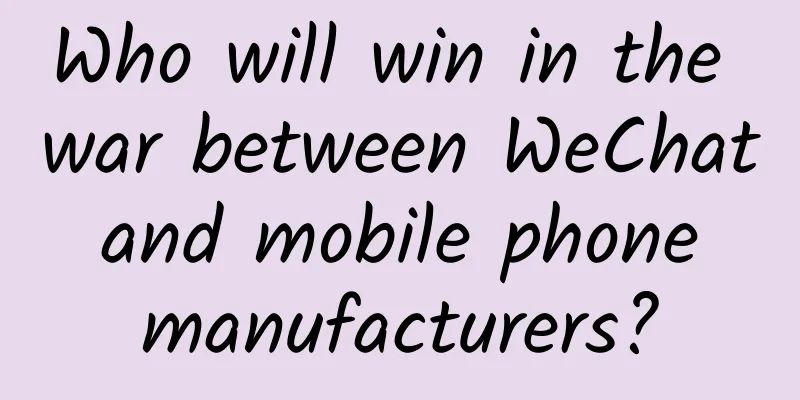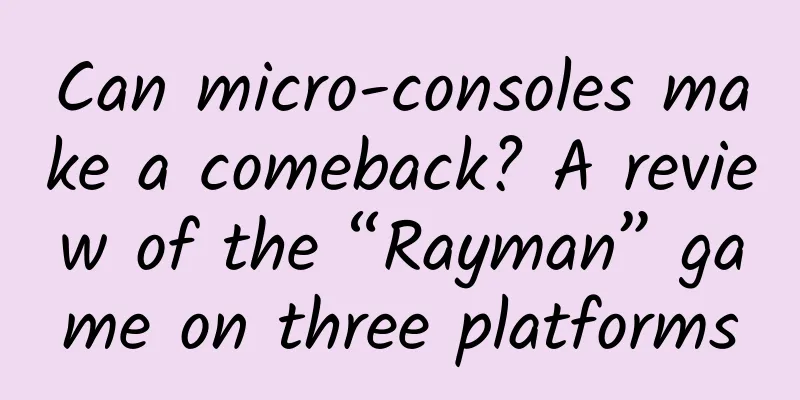Who will win in the war between WeChat and mobile phone manufacturers?

|
Recently, ten mobile phone manufacturers including Xiaomi, ZTE, Huawei, Gionee, Lenovo, Meizu, OPPO, vivo, OnePlus and Nubia jointly launched the Quick App standard and launched Quick Apps. The intention behind this is "turbulent". In fact, not only mobile phone manufacturers are targeting this, but Internet technology companies are also involved and have already made plans.
Giants enter the market On May 20, 2016, Google launched "Instant App", which allows users to experience the specific functions of an APP without installing the corresponding APP, similar to a mini version of an App. Following Google, Tencent launched "Mini Program" on January 9, 2017. The characteristics of Mini Program are that it does not need to be installed, is within easy reach, can be used and left, and does not need to be uninstalled. Whether it is a quick app, a mini program, or an Instant App, they all have one common feature, which is lightweight. What problems can lightweighting solve? This starts with installing an APP. As we all know, installing an APP requires opening up many permissions, including camera permissions, location permissions, contact permissions, network permissions, microphone permissions... Behind the opening of many permissions is actually the layer-by-layer consumption of power. Mobile phone manufacturers are undoubtedly aware of this problem, so quick apps were born. Of course, developers are also one of the beneficiaries. Quick apps achieve the lowest-cost access for developers through unified standards and jointly build a quick app ecosystem. In addition, construction is carried out at the levels of R&D interfaces, capability access, developer services, etc., and all categories are open to individual developers and corporate developers in a platform-based ecological model. At the same time, with the help of the huge user base and rich scenario-based entrances of hardware manufacturers, sufficient traffic support is provided for developers. In this regard, mobile phone manufacturers and Google have maintained a surprising agreement. At that time, when Google released Instant App, it said that developers who wanted to add Instant App functions did not need to develop a separate Instant App application. The original API and source code used were the same. Depending on the specific application, adding Instant App functions generally did not require additional development resources, and the fastest could be completed within a day. Not only that, Instant App can help them reach more users. For example, a group of users who were previously missed due to unwillingness to download the app may become the end users of the app after experiencing Instant App in the future. Yes, their collective ultimate goal is still users. No matter it is quick applications, instant apps or mini programs, by optimizing the experience, they solve the problem that users can experience the functions of the app without downloading it, thereby digging into users for the second time. The fight is about to begin In terms of user mining, there is no doubt that WeChat Mini Programs have come of age after a half-way storm. Data shows that since the launch of Mini Programs in January 2017, the number of WeChat Mini Programs has reached 580,000 by January 2018, with more than 170 million daily active accounts. At the same time, Mini Programs connect users to a wide range of online and offline services, including retail, e-commerce, life services, government affairs and people's livelihood, and games. In other words, the entrances to clothing, food, housing, transportation, and daily necessities in life scenarios have been controlled by WeChat layer by layer, step by step. In this context, the top ten mobile phone manufacturers are rushing into the market, and it is difficult to tell who will win and who will lose. At present, the top ten mobile phone manufacturers have nearly 1 billion smartphones in China, and 400 million new smartphones are shipped each year. It is reported that after the release of quick applications, each mobile phone manufacturer will quickly cover the existing 1 billion smartphone devices through application market releases, operating system OTA upgrades, etc., and new shipped devices will also be fully pre-installed with quick application engines. Behind the rapid speed is the determination of mobile phone manufacturers to dominate the application distribution. It should be understood that application distribution is an important source of income for mobile phone manufacturers. Taking the pre-installation of mobile phone apps as an example, it is reported that the mobile phone manufacturer charges between 2 yuan and 5 yuan for each partner software of each mobile phone. In other words, if a mobile phone with a shipment volume of 10 million units is installed with 15 pre-installed apps and users activate all of them, the mobile phone manufacturer's income will reach hundreds of millions of yuan. In addition to the licensing fee, many mobile phone manufacturers will also charge a certain amount of dividends from pre-installed apps. From this perspective, seizing the APP market is half the life of mobile phone manufacturers. However, can WeChat Mini Programs win all the way? Nowadays, WeChat has spread Mini Programs to every corner of the streets, hotels, supermarkets, hospitals, airports, etc. by integrating Mini Programs, WeChat Payment, QR code scanning, and card wallets. Whether it is WeChat QR code or Mini Program code, they can directly become traffic entrances by scanning the code. In fact, the offline merchants accumulated by mobile phone manufacturers and their ability to expand offline business should not be underestimated. In particular, the joint efforts of many mobile phone manufacturers can quickly complete the landing of a large number of quick application materials. Once the user is reached, the choice of which "code" the user will choose to scan may be full of variables. So, who can occupy the user's mobile phone desktop, QQ, WeChat or mobile phone manufacturers? |
<<: 5G will make your 4G mobile phone obsolete. How can you become a "pig" in the 5G trend?
Recommend
Wolf Warriors | How to Tame a Wolf
Author: Li Lu and Wu Cunshuang, Chief Pharmacists...
E-commerce market trends and product selection in June!
Which categories are hot-selling in various chann...
NetEase Youdao promotion strategy and advertising form!
Youdao Smart Selection is China's first mobil...
Which virtual host data storage rental hosting service provider should I choose?
Which virtual host data storage rental hosting se...
Community Operation | Master these 3 steps to make your community "live"
Most people who run communities have experienced ...
JavaScript Pretend Guide
This article adheres to If you don't understa...
How good is the product manager in a programmer’s dream?
The conflicts between programmers and product man...
Jia Yueting: If Samsung TV doesn't reform, it will be overthrown by LeTV
It is obvious that after experiencing the rapid v...
Android Advanced: In-depth understanding of the Android window management framework mechanism
[[423965]] Preface WindowManagerService is a wind...
After 80 years of research, the key factor that "playing mahjong can extend life" has been found, and it turns out to be...
Editor: Sunny Morning Many people love playing ma...
Chery angrily denounces Mercedes-Benz's new energy trademark infringement
Chery Automobile previously launched a micro pure...
As the temperature drops, please be careful of fire!
Cold winter Hand warmer, this "winter magic ...
When HDR becomes the standard for future TVs, are we still far away from better display effects?
Although the entire technology industry has inves...
Why is Panzhihua famous for mangoes? The dry and hot valley of the Jinsha River is a tropical fruit producing area in the subtropics
Although located in the subtropics, Panzhihua is ...
The path and enlightenment of EU artificial intelligence ethics and governance
Author: Cao Jianfeng, Senior Researcher at Tencen...









